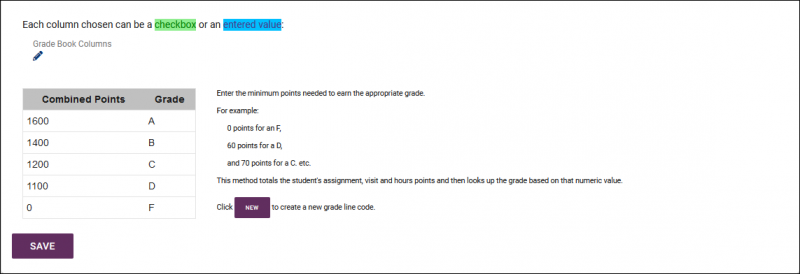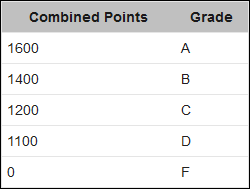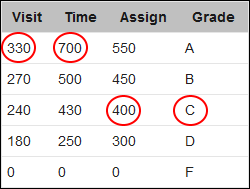|
|
Grade Groups & Potential Assignments
Grade Groups can be used to calculate registration grades based on the student's number of visits, total time, and/or completed assignments. You can control which of those data points applies to this calculation, how many points are awarded, and the threshold of total points required to achieve a certain grade.
This feature is primarily utilized in fitness centers, but there's nothing preventing this from also being used in centers of other types if you think in might be applicable for your use case.
1. Creating a Grade Group
The first step is creating a Grade Group. This is where you'll define how many points students will receive per action. To begin creating a grade group, go to Other > Other Options > Grade Groups. From the Grade Group Listing, click on the hamburger icon (File:Hamburger.png) and choose New Grade Group.
Screenshot: The Grade Group Entry page.
To begin, we need to decide what qualifies as the highest grade score. Let's say we have a 6 week course, and we want students visiting twice a week for an hour each time. Students will also be expected to complete one assignment per week.

- This is the name of this particular Grade Group. We'll be referring back to this name a few times, so make sure it's clear and unique.
- This determines how many points the student will receive per visit login. In some cases, you only want to reward total time rather than total logins, or both, or even neither. If you want to exclude this, simply leave the value as 0. In our case, we don't want students to visit for several hours at once, so we'll reward students who stagger out their 1-hour visits by providing points for separate visits.
- Similar to the above, we can reward points for visit time. In our case, we want to reward time more than login, so we'll say that the student gets 60 points per hour.
- This ties into the Grade Tables that we'll see later. Put simply, Min Points means that the grade will only be as high as the student's minimum score across Visits, Time, and Assignments, while Combined Total combines the points from each of the three categories and calculates grade based off that number alone.
- Maximum Visit/Time/Assignment Points
- This allows you to designate a point threshold where a certain action no longer contributes to the student's overall total. For example, we may not want to give a student an A grade if they completed twice the Assignments as expected while they never visited the center. So we're capping the Assignment points at 800, and if the student wants to progress further than 800, they must visit the center.
- Minimum Visit Time to Count
- This allows you to add a visit time threshold for when a visit counts towards a student's total points. For example, you probably don't want a 5-minute visit to count towards their total. In our example case, the minimum is 20 minutes.

- These are the linked assignments, which we will come back to in Step 2.
- This is where you will define how many points are needed for each grade. This changes depending on whether you're using Combined Total or Min Points as the Calculation Mode.
- Combined Total: In this case, it's as simple as clicking the New button, and adding grades and their respective minimum points to obtain. In our example scenario, if a student visits 6 times, for exactly 60 minutes each, and completes all 6 assignments, the total is 1680 (of the 2100 theoretical maximum). We'll set our A grade a little under that score at 1600, with the rest of the grades being scaled accordingly. F grade is anything between 0 and the second lowest grade.

- Min Points: This use-case gets slightly more complicated, but gives greater flexibility in preventing students from over-scoring in visit time, while ignoring assignments, or vise-versa. With this option, we can create a grade level for each possible source of points, and the student's final grade will be the lowest of the set. As an example, lets say our student has maxed out the Visit and Time values, for a total of 1300pts, but they've only scored 400 in their Assignments (bringing the total to 1700). This would result in an A grade if the above Combined Total table was being used. If we want to discourage this approach, we can setup a table like we see below. The student's lowest grade in each column will be their final grade. Our example student would receive a C in this case.

2. Creating a potential assignment
3. Examples
4. Registration Assignment Grid
|



